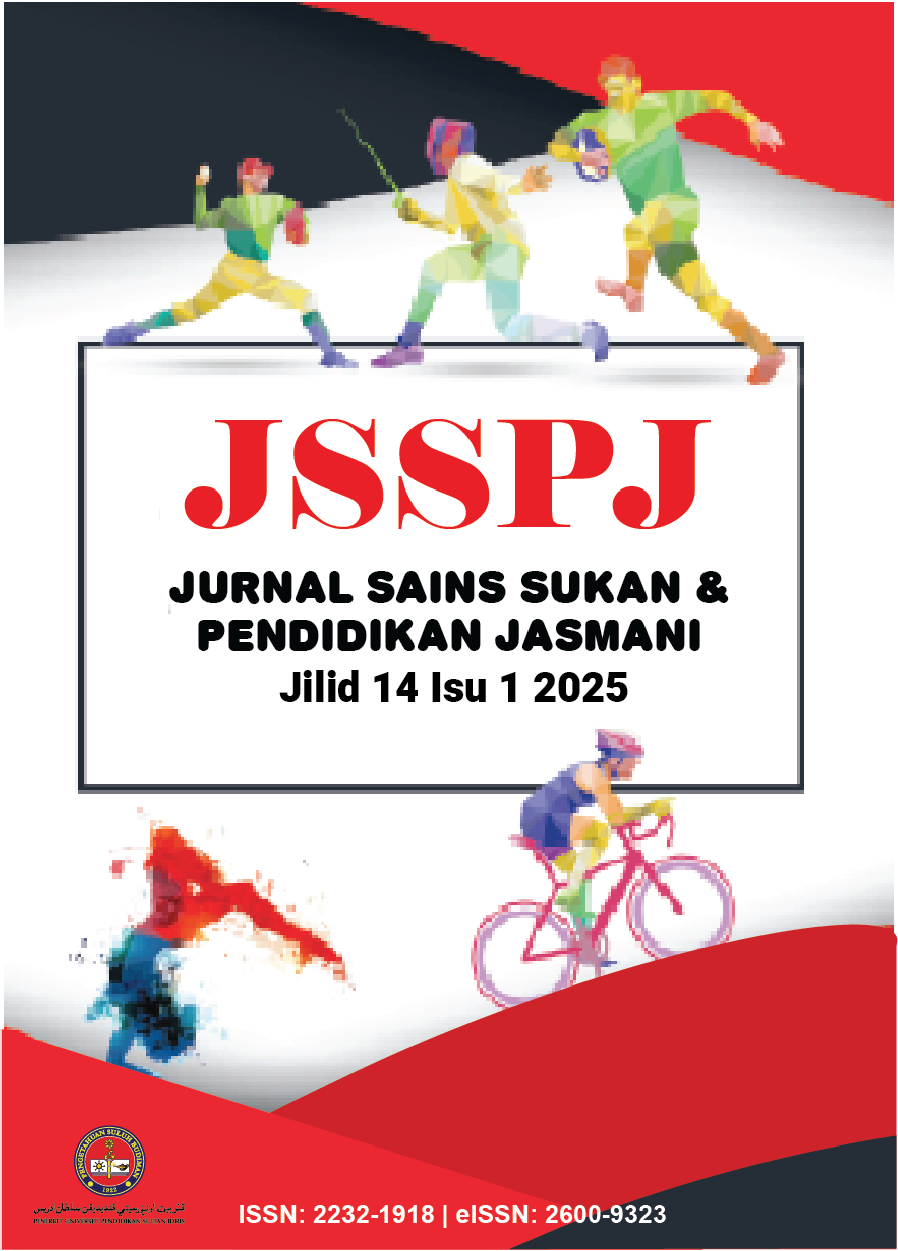Association Between Body Mass Index, Blood Pressure, and Blood Glucose Levels with Gender among Faculty of Sports Science and Recreation Staff at UiTM
DOI:
https://doi.org/10.37134/jsspj.vol14.1.3.2025Keywords:
body mass index (BMI), blood pressure, blood glucose, UiTMAbstract
High body mass index (BMI), blood pressure, and glucose levels lead to many diseases such as hypertension, diabetes, and cardiovascular disease (CVD). This study aimed to compare BMI on blood pressure and glucose levels among genders of the Faculty of Sports Science and Recreation (FSR), UiTM Shah Alam staff. The study involved 26 males, and 19 females aged between 24 and 60 years old who then participated in the health screening processes. Then the data was analyzed by using SPSS version 29. The significant level for male, and female BMI and systolic blood pressure is smaller than the p-value (p<0.05) indicating significance between BMI and systolic blood pressure (SBP) against male and female staff in FSR with a weak positive correlation. Meanwhile, the p-value for male and female BMI and blood glucose level is higher than 0.05 indicating no significance between BMI and blood glucose level against either male or female staff in FSR. The correlation of male BMI is a very weak negative correlation indicating an inversely proportional relationship between BMI and blood glucose level among the male staff. The study reveals that the association between BMI and blood pressure among male and female FSR employees is substantial, with a slight positive correlation. However, there is no significant relation between BMI and blood glucose levels among male and female FSR staff, with a mild negative correlation for males and a weak positive correlation for females.
Downloads
References
Bernabe-Ortiz, A., Carrillo-Larco, R. M., & Miranda, J. J. (2021). Association between body mass index and blood pressure levels across socio-demographic groups and geographical settings: Analysis of pooled data in Peru. PeerJ, 9, e11307. https://doi.org/10.7717/peerj.11307
Buckworth, J., & Dishman, R. K. (2002). Exercise psychology. Human Kinetics.
Ji, H., Niiranen, T. J., Rader, F., Henglin, M., Kim, A., Ebinger, J. E., Claggett, B., Merz, C. N. B., & Cheng, S. (2021). Sex differences in blood pressure associations with cardiovascular outcomes. Circulation, 143(7), 761–763. https://doi.org/10.1161/circulationaha.120.049360
Kang, N. L. (2021). Association between obesity and blood pressure in common Korean people. Vascular Health and Risk Management, 17, 371–377. https://doi.org/10.2147/vhrm.s316108
Koo, H. C., Tan, L. K., Lim, G. P., Kee, C. C., & Omar, M. A. (2023). Obesity and Its association with undiagnosed diabetes mellitus, high blood pressure, and hypercholesterolemia in the Malaysian adult population: A national cross-sectional study using NHMS data. International Journal of Environmental Research and Public Health, 20(4), 3058. https://doi.org/10.3390/ijerph20043058
Mohd-Sidik, S., Lekhraj, R., & Foo, C. N. (2021). Prevalence, associated factors, and psychological determinants of obesity among adults in Selangor, Malaysia. International Journal of Environmental Research and Public Health, 18(3), 868. https://doi.org/10.3390/ijerph18030868
Ng, M., Fleming, T., Robinson, M., Thomson, B., Graetz, N., Margono, C., Mullany, E. C., Biryukov, S., Abbafati, C., Abera, S. F., Abraham, J. P., Abu-Raddad, L. J., & Abu-Rmeileh, N. M. (2014). Global, regional, and national prevalence of overweight and obesity in children and adults during 1980–2013: A systematic analysis for the Global Burden of Disease Study 2013. The Lancet, 384(9945), 766-781. https://doi.org/10.1016/S0140-6736(14)60460-8
Omura, T., Goto, A., Nakayama, I., Saito, J., Noda, M., Yasuda, N., Saito, I., Kato, T.,Arima, K., Kawakami, F., Sakata, K., Tanno, K., Yamaji, T., Iwasaki, M., Yamagishi, K., Iso, H., Inoue, M., Tsugane, S., & Sawada, N. (2025). Socioeconomic status and diabetes prevalence in the Japanese: Insights from the JPHC-NEXT study. Mayo Clinic Proceedings, 100(3), 452–464. https://doi.org/10.1016/j.mayocp.2024.08.016
Regitz-Zagrosek, V. (2012). Sex and gender differences in health. EMBO Reports, 13(7), 596-603. https://doi.org/10.1038/embor.2012.87
Ruze, R., Liu, T., Zou, X., Song, J., Chen, Y., Xu, R., Yin, X., & Xu, Q. (2023). Obesity and type 2 diabetes mellitus: Connections in epidemiology, pathogenesis, and treatments. Frontiers in Endocrinology, 14, Article 1161521. https://doi.org/10.3389/fendo.2023.1161521
Warburton, D. E., Nicol, C. W., & Bredin, S. S. (2006). Health benefits of physical activity: The evidence. Canadian Medical Association Journal, 174(6), 801- 809. https://doi.org/10.1503/cmaj.051351
World Health Organization. (2021). Noncommunicable diseases progress monitor 2020. World Health Organization. https://www.who.int/publications/i/item/ncd-progress-monitor-2020
Zhang, F. L., Ren, J. X., Zhang, P., Jin, H., Qu, Y., Yu, Y., Guo, Z. N., & Yang, Y. (2021). Strong association of waist circumference (WC), body mass index (BMI), waist-to-height ratio (WHtR), and waist-to-hip ratio (WHR) with diabetes: A population-based cross-sectional study in Jilin Province, China. Journal of Diabetes Research, 8812431. https://doi.org/10.1155/2021/8812431
Downloads
Published
Issue
Section
License
Copyright (c) 2025 Ruziyati Mohamed, Nur Batrisyia Asmizan, Ruzianisra Mohamed, Hashbullah Ismail

This work is licensed under a Creative Commons Attribution-NonCommercial-ShareAlike 4.0 International License.





